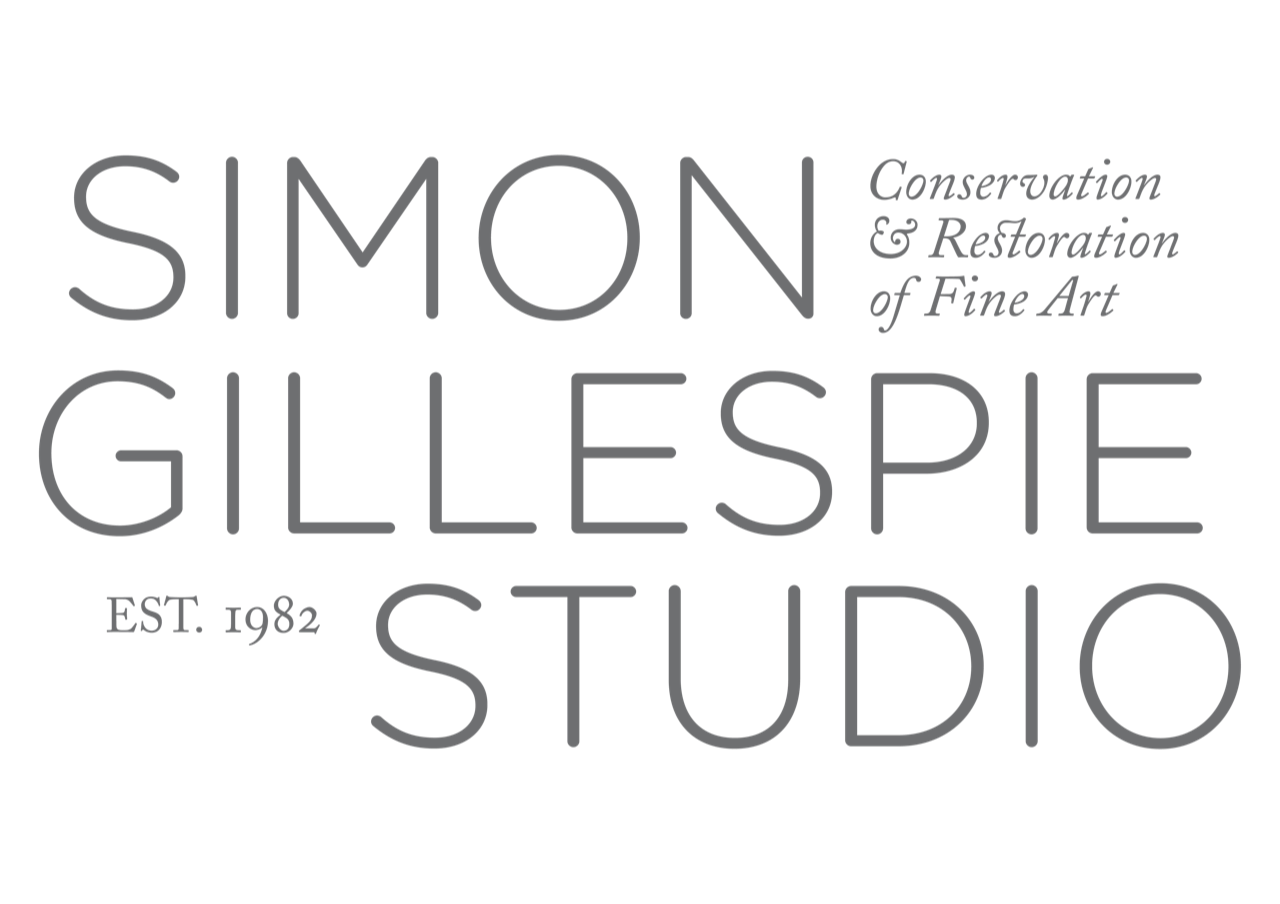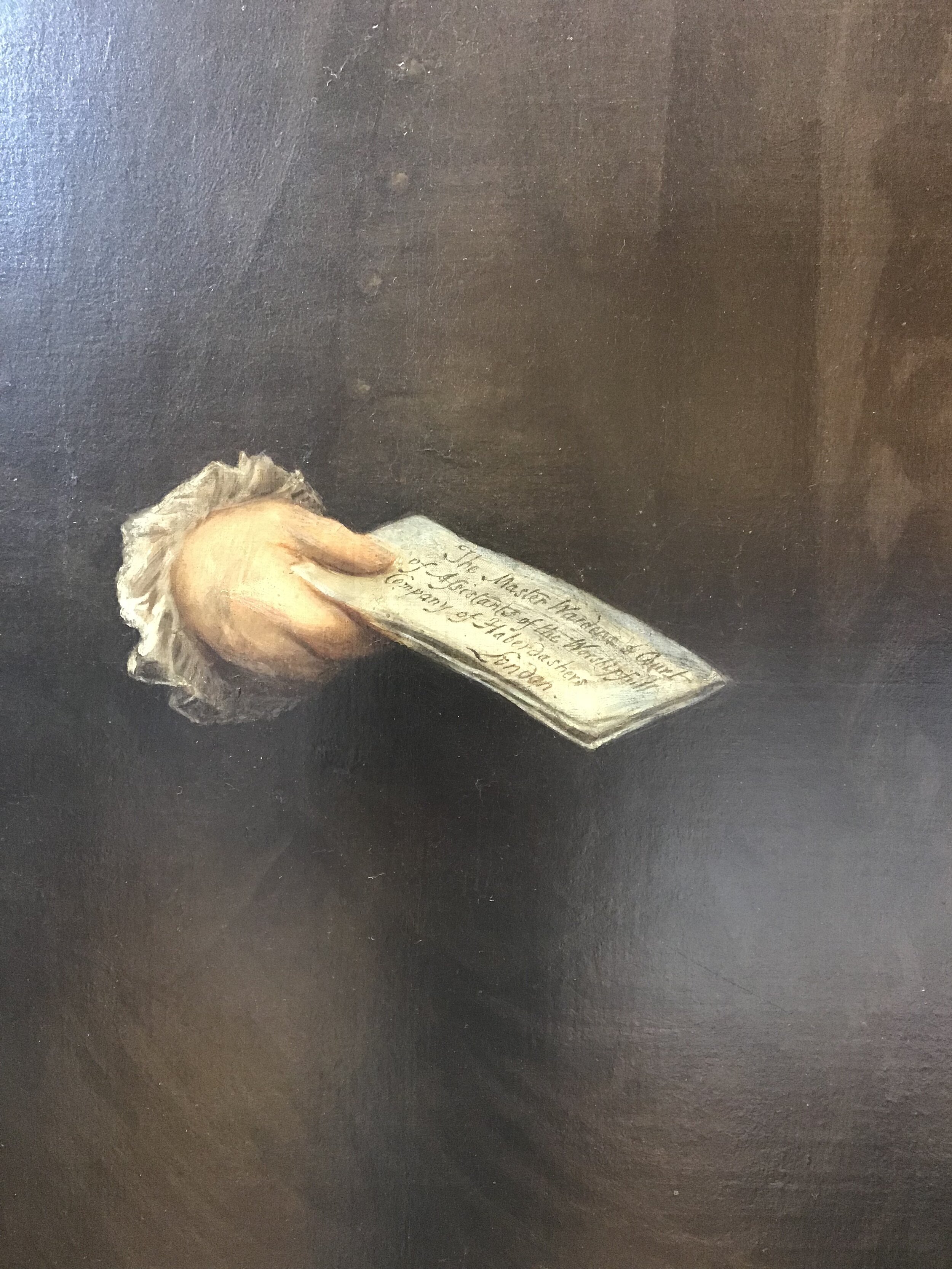Portrait of Jerome Knapp by Sir Thomas Gainsborough
Revealing the artist’s confident brushstrokes from under thick layers of discoloured varnish and extensive overpaint: a hugely rewarding project undertaken for the Worshipful Company of Haberdashers
Before treatment
After treatment
Jerome Knapp (1722-1792), was the Clerk of the Worshipful Company of Haberdashers from 1754 until 1790, and the positive impact of his administrative work continues to be felt to this day in the Company’s support of charitable causes. While he was still Clerk, it was decided during a meeting of the Company’s Court of Assistants in 1786 to commission a portrait of Knapp ‘in commemoration of such great and eminent services’. The portrait was to hang in the Hall. The portraitist Thomas Gainsborough (1727-1788), who was already established as a highly sought-after portraitist, was chosen as ‘a proper person’ to paint the portrait, and the Company even extended its original budget in order to meet Gainsborough’s commission. The portrait was completed in September 1787, and placed in a frame which had been purchased from the carver William Flaxman. A few months before it was finished, the portrait was declared to be ‘excellent in all its qualities, - and will be a charming ornament to the City-Hall in which it is to be fixed’.
The painting features an inscription which reads: ‘This portrait of Jerome Knapp Esqr: Clerk to the Worshipful Company of Haberdashers was first proposed by Mr: Joseph Malpas and seconded by Jno: Pardon Esqr: two worthy Members: and unanimously agreed to, at a Court of Assistants held Nov. 16:1786, in Rememberance of his Great and faithful Services, during 32 years. — Sir Benj. Hammet Kt: & Alderman, Then Master Painted by Thos: Gainsborough R:A”. The inscription has an interesting back story too: it was recorded in September 1787 to have been added on instruction from Mr Joseph Malpas without consent from the sitter, artist or Hall. It was decided by the Court that the inscription should be painted over, and the painting was returned to Gainsborough’s studio so that the artist could paint over it. However, when the portrait was cleaned in the 1910s, the inscription was revealed, and is visible to this day.
Reading about the artwork in Hugh Belsey’s catalogue raisonné of Gainsborough
Hugh Belsey, the author of the catalogue raisonné of Gainsborough works and formerly director of Gainsborough’s House for over two decades, writes that ‘to this day the portrait remains one of the Company’s greatest treasures’, and is an excellent late example of Gainsborough’s work for an institution. The painting is listed in Hugh Belsey’s catalogue raisonné under the catalogue number 553.
We know that the painting had to be rescued from the Hall when there was a fire in 1864, it may be in the aftermath of fire damage that the original Flaxman frame was replaced by a plainer moulding.
In 1915 someone wrote about the portrait that ‘many years ago it was described by a writer in the Art Journal as " repulsive in appearance from coats of discoloured varnish."‘
The portrait was treated in 1914, when it underwent cleaning. The cleaning methods and materials used appear to have been overly harsh and have abraded the surface of the paint film, causing the canvas texture beneath to become visible, resulting in a loss of detail in the composition. To cover up the abrasions, thick paint was then artistically applied, unnecessarily covering original paint. With the artist’s expressive confident brushstrokes thus concealed, the picture no longer looked like it had been painted by Gainsborough.
The original canvas has also been lined in the past, a process where a supporting canvas is adhered to the reverse of the original which had a number of small rips and damages.
Since 1915, the picture has accrued a substantial layer of dirt and dust, as is normal for any unglazed picture on display in London, and the varnishes have discoloured and dulled, making the picture difficult to view.
In 2019, on the recommendation of Hugh Belsey, Simon was invited by David Bartle, Archivist at Haberdashers’ Hall, to view the picture and discuss possible conservation treatment.
Simon thoroughly assessing the artwork on site, front and back, at the Haberdashers’ Hall
With a treatment plan agreed, the picture was brought to Simon Gillespie Studio.
The picture was firstly dusted front and back using soft brushes and velvet to remove a thick layer of dust, then surface cleaned. After that, the task was to remove the thick, waxy-looking and relatively recent varnish. Beneath the varnish, there was extensive overpaint on the painting, covering old damages. Testing was carried out to find the safest and most effective method to remove the discoloured varnishes and old repaint. The cleaning process took almost 100 hours.
With all the later layers removed, the artist’s original brushstrokes were visible again for the first time in years, which was hugely exciting to witness. Although it had been through a fire and in spite of several damages, the quality of the portrait was undeniable. The tonality in the flesh of the sitter had returned, making the portrait seem much more lifelike and naturalistic; details of his costume emerged such as the pompoms on his cloak and a seal from his waist; and the background was much more convincing.
The picture after removal of the discoloured varnishes and disguising overpaint, with all the past damages revealed
Structural treatment was then carried out. The edges of the old lining canvas had started to degrade and were beginning to detach from the stretcher frame, in addition, there was minute flaking suggesting that the old lining was no longer fulfilling its supportive role. The painting was therefore relined, ie the existing supporting canvas was removed and replaced with a new one.
After this began the process of reconstructing the damages in order to reintegrate them into the portrait. Again, this was a long process taking several dozen hours, carried out by senior conservator Léonie van der Graaf ACR, but the result has been well worthwhile.
Jerome’s head before treatment: rather cartoonish, with little modulation in colour or sense of the texture of flesh.
Jerome’s head after treatment
Detail of Jerome’s hand and costume before treatment
Detail of Jerome’s hand and costume after treatment. Note the seal that has been revealed at Jerome’s hip, previously concealed by overpaint. Note also that the buttons and pompoms on his costume and the texture of the fabric are now much more legible.
We were delighted that Hugh Belsey came to see the picture at the studio after treatment had been completed, and expressed his admiration at the quality revealed by our work. Hugh said: “it is transformed and with all the overpaint removed the character of the sitter has returned. Details of the stance and the costume have been revealed which give the portrait much more energy and show Gainsborough's characteristic handling of paint. […] I am so pleased the Council decided to go ahead with the full conservation job and that they can feel justly proud of result. […] I am only sorry that the illustration in my catalogue is now out of date!”
The treatment had been documented with photos throughout, and it was a moving moment when a final photograph was taken before our trusted art handlers returned the portrait to the Haberdashers’ Hall.
Photographing the artwork after treatment
The picture was put back into its frame on site and hung on the wall, where it can hopefully be enjoyed by many people for years to come.
The artwork back on display in the Hall
Shortly after the picture was put back on display in the Hall, David Bartle arranged for Simon to meet the Clerk Philip Thicknesse to describe the treatment process undertaken and what it had revealed. A very happy day!
L to R: Simon Gillespie, Philip Thicknesse, and David Bartle
References:
Hugh Belsey, 2019. ‘Jerome Knapp: Honouring his ‘great and eminent services’ in Haberdashers Company magazine
Hugh Belsey, 2019. Thomas Gainsborough: the portraits, fancy pictures and copies after old masters.
Would you like to see case studies of other artworks by Thomas Gainsborough treated at Simon Gillespie Studio? Find these on our page dedicated to Gainsborough, or return to our Artists page.













